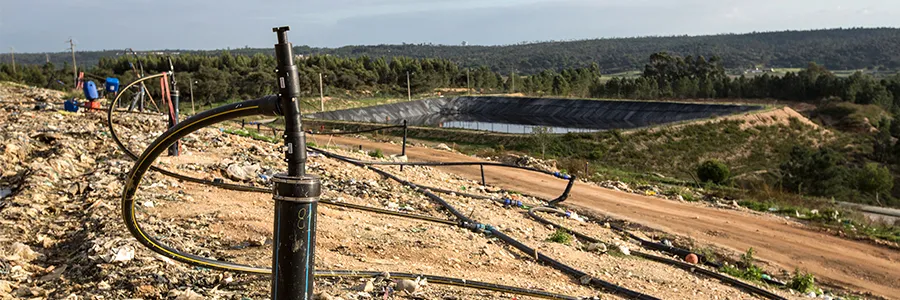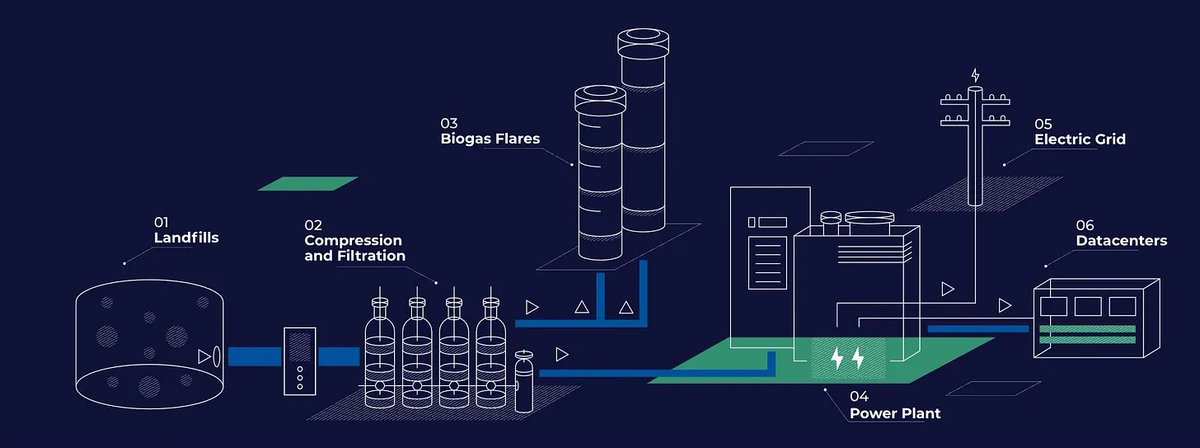
The last few months eco-friendly #Bitcoin mining or biomining has been a trending topic. I looked into the opportunity for miners using wasted or stranded #biogas as an input. Making Bitcoin mining a #CarbonNeutral or even #carbon negative operation. 🧵👇 

#Biogas is produced through a process called anaerobic digestion. A series of biological processes in which micro-organisms break down biodegradable material in absence of oxygen. Inputs can be:
- Waste crop residues
- Animal manure
- Municipal Solid Waste
- Wastewater sludge
- Waste crop residues
- Animal manure
- Municipal Solid Waste
- Wastewater sludge

The precise composition of biogas depends on the type of feedstock and the technology used to produce it. The main technologies applied are:
- Biodigesters
- Landfill gas recovery systems
- Wastewater treatment plants
- Biodigesters
- Landfill gas recovery systems
- Wastewater treatment plants

Biogas can be combusted to generate electricity to use on-site or sell to the grid. It is also used for heating, cooking and transportation fuels.
Producing, capturing and distributing biogas is an expensive operation. That is why it's often flared or vented.
Producing, capturing and distributing biogas is an expensive operation. That is why it's often flared or vented.

Biogas remained largely untapped as a power source for Bitcoin mining because the process is technically more complex than just connecting to the electrical grid. Biogas can provide 100% uptime making it an attractive supply load for miners.
https://twitter.com/BioMining/status/1450079022759747585?s=20&t=ENACFT0CnHdi1pF1HG_82A
There are 2 business models that are usually applied:
1/Biogas producer invests in the data centre and mining equipment
2/Miner purchases the energy produced
The owner of the data centre can manage a self-mining operation, hosting services or a combination thereof.
1/Biogas producer invests in the data centre and mining equipment
2/Miner purchases the energy produced
The owner of the data centre can manage a self-mining operation, hosting services or a combination thereof.

Bitcoin mining is mainly an economically viable possible solution in case biogas production/capturing systems are already in place. Biggest opportunities can be found where biogas is #wasted and/or #stranded or in case a production site is not operating at full capacity.
There are built-out biogas plants with a lack of demand onsite or grid connections fail to materialize. Leaving biogas producers heavily invested. Mining operations can provide the demand producers are looking for to recover their investment.
https://twitter.com/ScillingMining/status/1554701093082365953?s=20&t=Gzwh41w_ZvTL1BxtzRaSzA
If a landfill has a gas capturing system in place but is flaring or venting the gas, mining can monetize that wasted gas while reducing methane and CO2 emissions. 

Miners can also step in when a biogas plant is not running at full capacity. Bitcoin mining can monetize the underutilized part of the operation which could accelerating the ROI of the investments in anaerobic digester, generators and other infrastructure needed for production.
By reducing methane emissions, a biogas operation can become more environmentally sustainable and beneficial for the planet. “Biomining” can be considered carbon negative when methane would otherwise be flared or vented straight into the atmosphere.
https://twitter.com/DSBatten/status/1566735902617276416?s=20
In 2021 there were ~20,000 anaerobic digesters operating worldwide and ~1,000 new plants being deployed each year. Most production today comes from crops and animal manure. The biogas production is concentrated in Europe, China and the US (90% of global production). 

#Europe is the largest producer of biogas whereby #Germany produces two-thirds of Europe’s biogas. The governments in European countries actively promoted biogas production. In Europe over 75% of the biogas production comes from the agro-food industry.
The US has the biggest production of biogas produced at landfills. The states of CA/TX have the highest #landfill gas #emissions and perform best at mitigating emissions using traditional methods.
https://twitter.com/Vespene_Energy/status/1587463193864986626?s=20&t=pOBKpJd-wcuaBjqDSbfcIA
Would you like to know more details about the opportunities for #bitcoinmining using biogas, check out my newsletter below.
Subscribe for free if you want to stay up-to-date about everything related to #Bitcoin mining!
open.substack.com/pub/nicosmid/p…
Subscribe for free if you want to stay up-to-date about everything related to #Bitcoin mining!
open.substack.com/pub/nicosmid/p…
• • •
Missing some Tweet in this thread? You can try to
force a refresh





